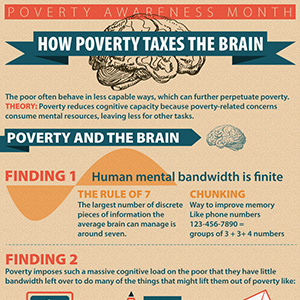This poverty infographic from the Social Work Degree Center depicts how poverty burdens the brain and is another disadvantage for the poor.
Poverty Burdens Infographic
Poverty and the Poor
The poor often behave in less capable ways, which can further perpetuate poverty.
THEORY: Poverty reduces cognitive capacity because poverty-related concerns consume mental resources, leaving less for other tasks.
Defining American Poverty:
- One in 8: number of people in the United States lives below the poverty line, which is $22,113 for a family of four in 2010. One in 5: number of children in the U.S. who live below the poverty line.
- 51.4: percentage of Americans who will live in poverty at some point before age 65.
- $14,500: Annual salary of a person working full-time at the minimum wage with a family of three.
- $17.568: The official poverty line for a family of three—one parent with two children.
- Did you know? 1 in 4 African Americans lives below the federal poverty line, compared to about 1 in 8 Americans overall.
- 2006-2010: percent of Americans living below the poverty line has increased each year, from 12.3 percent in 2006 to 15.1 percent in 2010.
- 2011-2012: poverty holds at 15 percent, or 46.2 million people living below the poverty line.
Poverty Rates: A Comparison
- The U.S. as a whole: 15%
- African Americans: 27.2%
- Hispanics: 25.6%
- Asians: 11.7 %
- Whites: 9.7 %
Poverty and Families
- 48 million: number of people without healthcare coverage, prior to Obamacare rollout.
Poverty - In 2012, the family poverty rate and the number of families in poverty were 11.8 percent and 9.5 million. Neither level was statistically different from the 2011 estimates.
- In 2012, 6.3 percent of married-couple families, 30.9 percent of families with a female householder and 16.4 percent of families with a male householder lived in poverty
Sex - In 2012, 13.6 percent of males and 16.3 percent of females were in poverty.
Age - In 2012, 13.7 percent of people 18 to 64 (26.5 million) were in poverty compared with 9.1 percent of people 65 and older (3.9 million) and 21.8 percent of children under 18 (16.1 million).
Regions
- The West was the only region to show a statistically significant change in its poverty rate, which declined from 15.8 percent in 2011 to 15.1 percent in 2012.
- The South was the only region in which the number in poverty changed, rising from 18.4 million in 2011 to 19.1 million in 2012.
Rich vs. Poor
Since the 1970s, the top 1 percent of earners in the U.S. has roughly doubled its share of the total American income pie to nearly 20 percent from about 10 percent. The richest 1% of people own nearly half of all of the wealth on the planet. Furthermore, the richest 10% of people claim 86% of global wealth.
Poverty Burdens the Brain
FINDING 1: Human mental bandwidth is finite.
THEORY: The Rule of 7: the largest number of discrete pieces of information the average brain can manage is seven, plus or minus 2. Chunking: ways to improve memory: Think about things like phone numbers (in the U.S.: 123-456-7890; that is, groups of 3 + 3+ 4 numbers), U.S. Social Security numbers (123-45-6789; that is, groups of 3+2+4 numbers), and worldwide postal codes.
FINDING 2: Poverty imposes a massive cognitive load on the poor. Therefore, they have little bandwidth left over to do many of the things that might lift them out of poverty like going to night school, Searching for a new job, or remembering to pay bills on time. So poverty makes individuals susceptible to making bad decisions. Additionally, the condition of poverty imposed a mental burden equal to losing 13 IQ points. So, this is the equivalent of losing a night’s sleep.
Poverty and IQ FACTS:
- 90 and 110: average I.Q; over 120 is superior.
- 68% of the U.S. population has an IQ between 85 and 115.
- Between 70 and 130 I.Q.: Represents about 95% of the population.
- 1% of the population has an IQ of 136 or higher.
HOLY COW: Harvard economist Sandhil Mullainathan: “Poverty is the equivalent of pulling an all-nighter. Picture yourself after an all-nighter. Being poor is like that every day.” Poverty is a bigger risk factor for mental illness than being exposed to warfare.
Related:
- Left in a Right World
- Looking for Leaders: The Crisis in Social Work
- Poverty in America: Then and Now
- Romanticizing Poverty
- Smoke Without Fire
- Suicide Notes
- The Changing Demographics of the Welfare State
- The Faces of Homelessness Today
- The Social Impact Of Mixing Business & Medicine
- The State of Children’s Health
- The War Within: Sexual Abuse in the Military
- Who Needs Social Workers?



